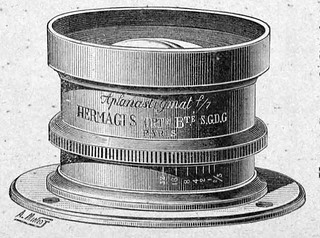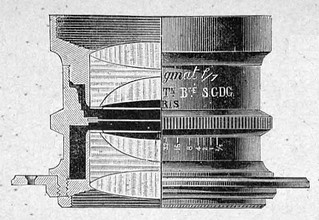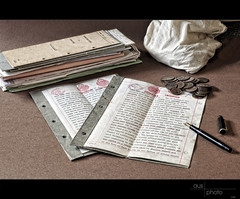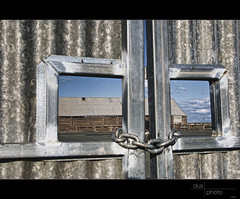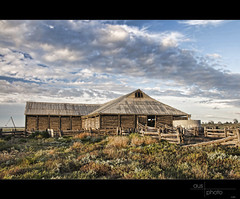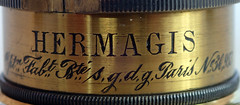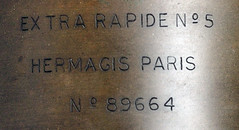User:Heritagefutures/Hermagis
| FEEL FREE TO LOOK, BUT PLEASE DO __NOT__ TOUCH... suggestions and additions are very welcome, but please leave them as a comment on the discussion page… thank you! |
| PLEASE DO NOT LINK THIS PAGE UNTIL FINISHED--MY SANDBOX IS OVERFLOWING |
Contents
- 1 Hermagis
- 2 Hermagis Eidoscope
- 3 Hermagis Anastigmat
- 4 Hermagis Aplanat
- 5 Hermagis Aplanastigmat
- 6 CASKET entry for terminology category
- 7 E. Français
- 8 E. Français Trousse Sets
- 9 Hermagis Trousse Sets
- 10 Hermagis Major
- 11 Hermagis Magir
- 12 Hermagis Inscription Types
- 13 Hermagis Serial Numbers
Hermagis
| French | () | |
|---|---|---|
| companies | ||
| AFR | Alsaphot | André and Lieutier | Angénieux | Arca Swiss | As de Trèfle | Atoms | Aubertin | Balcar | Bardin | Bauchet | Baudry | Bellieni | Berthiot | Boumsell | Boyer | Bronzavia | Cindo | Cord | Cornu | Coronet | Darlot | Demaria-Lapierre | Derogy | Faller | FAP | Fex | Français | Compagnie Française de Photographie | Gallus | Gaumont | Georges Paris | Girard | Gitzo | Goldstein | Héard & Mallinjod | Hermagis | Idam | Itier | Jousset | Joux | Kafta | Kinax | Kodak Pathé | Krauss | Lumière | Lund | Mackenstein | Manufrance | MAPED | Mazo | MFAP | MIOM | Mollier | Mundus | Olbia | Omega | OPL | Pierrat | Richard | Richard (Jules) | Roussel | Royer | SEM | Secam | SIAP | Soulé | Spirotechnique | Tiranty | Vergne | Zion (France) | ||
Hermagis was a French company, founded in 1845 in Paris.[1]
, active from the XIXth century to the mid-XXth century.
Hermagis also reputedly manufactured the cinema projection lenses sold by and branded as Pathé.[2]
Over time the ownership of the company Hermagis changed hands. It is listed as:
J. Fleury-Hermagis (~1886 > ~1914) with premises at 18 Rue Rambuteau, Paris 3ème[3]
H.P. du Motel (~1919) with premises at 29 Rue de Louvre, Paris 2ème.[4]'
Hermagis / P. Guilame & Cie. (~1933) with premises at 29 Rue de Louvre, Paris 2ème.[5]
In addition to lenses and cameras, Hermagis also manufactured and sold a variety of other optical products, such as opera glasses[6] and field binoculars[7], ¶¶
Lenses
Hermagis lenses carry sequential serial numbers irrespective of focal length or design. The sides of the lens cells are inscribed with 'Hermagis á Paris' or merely 'Hermagis Paris' as well as the focal length and year of production (first etched, later in pencil).
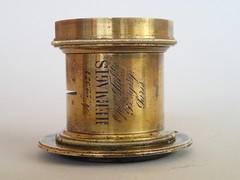
|
| Aplanat nº 8 (s/n 22527) image by Dirk HR Spennemann (Image rights) |
Lens Types
In addition to lenses for still photo cameras, Hermagis also manufactured and sold lenses for movie cameras and film and slide projectors as well as enlargers. These are set out below.
Still Photo Cameras
Hermagis offered its still photo lenses with the following names:
- Anastigmat lens, 20–400mm (variants → Anastigmat)
- Aplanat / Aplanat Grand Angulaire / Aplanetique
- Rapid Rectilinear-type lens, 140–540mm (variants → Aplanat)
- An anastigmatic six-element version of the Aplanat, 85mm – 310mm (variants → Aplanastigmat)
- ¶¶¶ lens, 70mm—460mm (variants → Eidoscope)
- Extra Rapide
- Extra Rapide Nº 5[10]
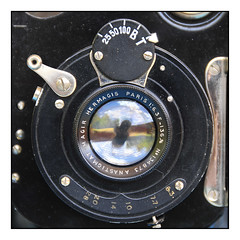
|
| Magir 136mm f/6.3 in Héard & Mallinjod 'Hemax' 6 x9 plate camera image by Dirk HR Spennemann (Image rights) |
- Magir (~late 1920s–1930s)
- Anastigmat lens for use in folding cameras, 105–136mm (variants → Magir)
- Major (~late 1920s–1930s)
- Anastigmat lens for use in folding cameras, 75–136mm (variants → Major)
- Neo-Stigmat
- 55mm f/6.8[13]
- Néo-Stigmat Hermagis f/6.8 ~1914
- Simple Rapide
- Simple Rapide Nº 5[20]
- Casket sets of lens barrels with a series of exchangeable front and back lens groups (details → Hermagis Trousse Sets)
Movie Cameras
- Anastigmat lens, 20–400mm (variants → Anastigmat)
- Ampli-Pathé f/2[21]
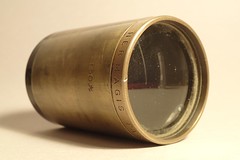
|
| Hermagis Objectif Cinema 150mm image by Dirk HR Spennemann (Image rights) |
Projection and Enlarger Lenses
- Cinema / Cinema SOM
- Petzval-type projection lens, 85mm—190mm (variants → Cinema)
- Petzval-type projection lens for 35mm slide projectors, 35–65mm (details → Magister)
Serial Numbers
The edges of the glass cells of Hermagis lenses were marked with the etched name 'Hermagis opticien', and the year of manufacture. A list of known serial number and date combinations can be found on this page.
Cameras
¶¶
In the 1930s Hermagis sold a number of cameras that were essentially imported camera shells (body, front standard and bellows) which the company fitted with its own lenses set in German and French (mainly Gitzo) shutters and distributed under its own name.

|
| Hermo Box (~1925) image by Iza Lemargouillat (Image rights) |
CHECk THE LENS IN HERE Alethoscope Hermagis http://www.ebay.fr/itm/Alethoscope-Hermagis-/251417183283 http://jgphot.free.fr/collection/stereo.php http://www.stereoantica.com/marques/j/joux-louis/alethoscope-45-x-107-bois
- L'Eclaireur (1897) a detective camera for 9x12 cm exposures on long roll film
- L'Eclaireur (~1914) model A (folding)
- 8x10½ cm exposures on roll film ¶¶REF TO BE ADDED
- 9x12 plates ¶¶REF TO BE ADDED
- L'Eclaireur (~1914) model B (folding)
- rollfilm version
- 6x9 cm rollfilm ¶¶REF TO BE ADDED
- 8x10½ rollfilm ¶¶REF TO BE ADDED
- 8x14 rollfilm ¶¶REF TO BE ADDED
- plate back
- 6.5x9cm plates ¶¶REF TO BE ADDED
- 9x12cm plates ¶¶REF TO BE ADDED
- 9x14cm plates ¶¶REF TO BE ADDED
- rollfilm version
- Hermak (1930s)
- Hermo 30 (9x12) (1930s)[22]
- Hermo-Box (6x9 box)
- Hermo-Cady
- four lens camera, 1860
- Hermo-Plak (1930s)
- Hermo-Plaket (1930s)
- Hermo-Prochette (1930s)
- Hermo-Selo (1930s) 6x9 self-erecting spring folder[28]
- Hermo-Trotter (1930s)
- Hippographe pliant (strut-folding in various plate sizes) (~ 1910)
- Hippographe reflex carré (SLR in various plate sizes) (~1910)
- Jumelle, 1885-
- Jumelle Stereo, 1885-
- Microjumelle Stereo
- with Aplanastigmat 85mm f/6.8[30]
- with Neo-Stigmat 55mm f/6.8[31]
- Micromégas (13x18), 1875-
- Micromégas[32]
- Micromégas Modèle A (9x12) with objectif rectiligne f/8 ~1914 [33]
- Micromégas Modèle A bis (9x12) with objectif rectiligne f/8 ~1914[34]
- Micromégas Modèle B (9x12) with objectif rectiligne f/8 ~1914[35]
- Micromégas Modèle C (9x12 and 10x15) with Aplanétique 1/2 grand-angle Hermagis f/7 ~1914[36]
- Micromégas Modèle D (6.5x9, 9x12, 10x15, 13x18)
- Micromégas Modèle E Métallique (6.5x9, 9x12, 10x15, 13x18) with ~1914[39]
- Micromégas Modèle F Universel (9x12 horizontal) with ~1914[42]
- Micromégas (6.5x9 strut folding), 1920s
- Vélocigraphe (9x12 or 13x18), with
- Anastigmat f/9
- Aplanastigmat extra rapide f/6.8, 1890-
- Aplanastigmat No.8 140mm[45]
- Wenz Hermagis, 1910, for kite photography [46]
Patents
Photographic apparatus. Being British Patent Number: 937 published 13 March 1875
Publications
Books
J. Fleury-Hermagis (1889) L'atelier de l'amateur. Bibliothèque de l'amateur photographe. 2ème edition. Paris: G. Rongier & Cie. 70 pp.
J. Fleury-Hermagis & A. Rossignol (1889) Traité des excursions photographiques. Bibliothèque de l'amateur photographe. Paris: G. Rongier & Cie. 484pp. (online copy at www.e-corpus.org)
J. Fleury-Hermagis & A. Rossignol (1890) Traité des excursions photographiques. Bibliothèque de l'amateur photographe. Paris: Maison Hermagis. 484pp
J. Fleury-Hermagis & A. Rossignol (1897) Traité des excursions photographiques. Bibliothèque de l'amateur photographe. Paris: Maison Hermagis.
Magazines
L'amateur d' excursions photographiques. (1895—) edited by J. Fleury-Hermagis. Paris: Hermagis 18 Rue de Rambuteau.
- (as page images the followoing issues are available online: nº1, October 1895; nº2, April 1896; nº3, January 1897; and nº4, June 1898).
Catalogues
* 1886 http://www.ebay.com/itm/italyfoto-2-rares-catalogues-photographiques-HERMAGIS-1886-1900-ca-/291051329338?pt=FR_IQ_Photovidéo_Photo_Appareils_Argentiques&hash=item43c402d73a
- 1914—Optique de Précision. Appareils et Fournitures Genérales pour la Photographie. J. Fleury-Hermagis. 18 Rue Rambuteau, Paris 3ème (catalogue pages of cameras only); reproduced by Sylvain Halgand on www.collection-appareils.fr.
- 1933?—Optique and Mécanique de Précision. Appareils pour la Photographie. Etablissements Hermagis (reproduced by Sylvain Halgand on www.collection-appareils.fr).
Links
Lenses
- Eidoscope sample images on Flickr
- Strip-down documentation of Hermagis Extra Rapide Nº 5 s/n 89664 (1924) (Photographica Collection Dirk HR Spennemann).
Cameras
- The Hermagis Micromégas and Vélocigraphe at Historically Important Cameras
- A later Micromégas at Francis Lamirault's site
- Hermagis cameras on www.collection-appareils.fr by Sylvain Halgand
- Hermagis and a page about Fleury-Hermagis at Gérard Langlois site
- Two cameras with Hermagis lens, bodies maybe made by Hermagis too
- A Siva with Hermagis lens
Notes and References
- ↑ Discussion thread in Galerie Photo
- ↑ Discussion thread in Galerie Photo.—An examination of two Pathé Frére Paris Extra-Lumineux 150mm projector lenses (both Photographica Collection Dirk HR Spennemann) showed no markings on the sides of the front cells or any other indication that this is the case.
- ↑ 1914 Catalogue
- ↑ Prix-Courant des Appareils Pliants "Micromegas" 1 August 1919 (seen seen in an online auction; Dec 2013)
- ↑ Extrait du Catalogue General 1933 (seen seen in an online auction; Dec 2013); (1933? catalogue on www.collection-appareils.fr). (
- ↑ opera glasses
- ↑ Model 'Clara 8x30' (seen in an Italian on-lne market site, Feb 2014)
- ↑ s/n 111227 (seen in an online auction; Oct 2013)
- ↑ Sylvain Halgand's site
- ↑ s/n 89664 (1924) Strip-down documentation of lens (Photographica Collection Dirk HR Spennemann).
- ↑ s/n 151818 (seen in an online auction; Nov 2013)
- ↑ s/n 253808 (seen in an online auction; Oct 2013)
- ↑ 48303 (left) and 48304 (right) in Hermagis Microjumelle (seen in an online auction; Jan 2014).
- ↑ * Micromégas Modele D on www.collection-appareils.fr by Sylvain Halgand
- ↑ * Micromégas Modele E on www.collection-appareils.fr by Sylvain Halgand
- ↑ * Micromégas Modele F on www.collection-appareils.fr by Sylvain Halgand
- ↑ s/n 45060 (seen in an online auction Jan 2014); s/n74582 (seen in an online auction).
- ↑ s/n37251 (seen in an online auction).
- ↑ s/n31300 (seen in an online auction).
- ↑ with rotary diaphragm marked 2-32,"engraving "Hermagis opt.Fab.Bte.sgdg.Paris N° 26805" and "Simple rapide N°5"; 71 mm high, Ø74mm, weight 456 gr (seen in an online auction; Jan 2014).
- ↑ s/n 2259097 (seen in an online auction, Feb 2014).
- ↑ shop box only; s/n 132115 (seen in an online auction; Dec 2013)
- ↑ The 3x4 version of the Cady was a rebadged Zeca Goldi with a Hermagis lens.
- ↑ Sylvain Halgand's site
- ↑ The Cady was a 6x9 self-erecting spring folder, probably of Germany manufacture, that was fitted with French lens and shutter combinations and sold by French photo supply chains with OEM-sourced but generic-labelled lenses (e.g. sold by Photo-Plait, Photo-Hall etc.) and also under various manufacturers' names, such as the Gallus Cady.
- ↑ s/n243753 (seen in an online offering; Jan 2014); s/n 244165 (seen in an online auction; Dec 2013).
- ↑ Sylvain Halgand's site
- ↑ The Cady was a 6x9 self-erecting spring folder, probably of ¶¶ manufacture, Germany manufacture, that was fitted with French lens and shutter combinations and sold by French photo supply chains with OEM-sourced but generic-labelled lenses. Hermagis marketed it as the Hermo-Selo.
- ↑ (seen in an online offering; Jan 2014);
- ↑ body s/n 942; left lens s/n 51356; seen in an on-line auction (Jan 2014)
- ↑ 48303 (left) and 48304 (right) in Hermagis Microjumelle (seen in an online auction; Jan 2014).
- ↑ Hermagis Micromégas on www.collection-appareils.fr by Sylvain Halgand
- ↑ Micromégas Modele A on www.collection-appareils.fr by Sylvain Halgand
- ↑ Micromégas Modele A bis on www.collection-appareils.fr by Sylvain Halgand
- ↑ Micromégas Modele B on www.collection-appareils.fr by Sylvain Halgand
- ↑ Micromégas Modele C on www.collection-appareils.fr by Sylvain Halgand
- ↑ Micromégas Modele D on www.collection-appareils.fr by Sylvain Halgand
- ↑ Micromégas Modele D on www.collection-appareils.fr by Sylvain Halgand
- ↑ Micromégas Modele E on www.collection-appareils.fr by Sylvain Halgand
- ↑ Micromégas Modele E on www.collection-appareils.fr by Sylvain Halgand
- ↑ Micromégas Modele E on www.collection-appareils.fr by Sylvain Halgand
- ↑ Micromégas Modele F on www.collection-appareils.fr by Sylvain Halgand
- ↑ Micromégas Modele F on www.collection-appareils.fr by Sylvain Halgand
- ↑ Micromégas Modele F on www.collection-appareils.fr by Sylvain Halgand
- ↑ Velocigraphe 9x12cm, s/n 1137, with Hermagis Aplanastigmat No.8 140mm s/n 34383, seen in on-line auction (Dec 2013).
- ↑ see [1] and [2]
| FEEL FREE TO LOOK, BUT PLEASE DO __NOT__ TOUCH... suggestions and additions are very welcome, but please leave them as a comment on the discussion page… thank you! |
Hermagis Eidoscope
The Hermagis Eidoscope is a [¶¶¶ lens (¶¶¶) that was produced by Hermagis from ¶¶¶ to 19¶¶ and by SOM from 19¶¶ onwards. It was offered first in lacquered, then in black painted brass and came in a range of sizes:
Barrel lenses
Lens Cells only
- Eidoscope f/4.5 150mm lens cells in casket[8]
Notes and References
- ↑ s/n 47709 (seen in an online auction).
- ↑ s/n 132835; 132845 , 150960 (seen in an online auction); s/n 353344 (online auction; Dec 2013)
- ↑ s/n 69817 (seen in an online auction); 140357 (Chinese online auction; Feb 2014); 164901 (online auction).
- ↑ s/n 305161 (seen in an online auction; Feb 2014)
- ↑ s/n 48929 (seen in an online auction).
- ↑ s/n 110814 (seen in an online auction).
- ↑ s/n 161981 (seen in an online auction).
- ↑ s/n 294554 (seen in an online auction; Jan 2014)
| FEEL FREE TO LOOK, BUT PLEASE DO __NOT__ TOUCH... suggestions and additions are very welcome, but please leave them as a comment on the discussion page… thank you! |
Hermagis Anastigmat
The Hermagis Anastigmat is a [¶¶¶ lens (¶¶¶) that was produced by Hermagis from ¶¶¶ to ¶¶¶ and was offered in a range of sizes:
- Anastigmat
- Anastigmat Nº 7
- 210mm f/4.5[5]
- Anastigmat Serie TP Nº 5
- 400mm [6]
- Anastigmat Major (see also Hermagis Major)
- 50mm f/4.5[7]
Notes and References
- ↑ s/n 77302 (seen in an online auction; Oct 2013); s/n 86455 (seen in an online auction; Feb 2014).—See also this flickr image, and vintage-cameras.com
- ↑ s/n 58107 (seen in an online auction; Oct 2013); s/n 87547 (seen in an online auction; Jan 2014);
- ↑ s/n 171595 (seen in an online auction; Jan 2014);
- ↑ s/n 87707 (seen in an online listing; Feb 2014);
- ↑ s/n 51090 (seen in an online auction; Oct 2013)
- ↑ s/n 354809 (seen in an online auction; Oct 2013)
- ↑ s/n 329240 (seen in an online auction; Nov 2013)
| FEEL FREE TO LOOK, BUT PLEASE DO __NOT__ TOUCH... suggestions and additions are very welcome, but please leave them as a comment on the discussion page… thank you! |
Hermagis Aplanat

|
| Hermagis Aplanat nº 8 with Waterhouse stops (s/n 22527, right) and diaphragm (s/n 30953, left) image by Dirk HR Spennemann (Image rights) |
The Hermagis Aplanat is a Rapid Rectilinear-type lens (symmetrical, 4 elements in 2 groups) that was produced by Hermagis from mid-1880s until World War I. It was offered first with Waterhouse stops and from the 1890s onwards with a diaphragm. Based on the observed serial number data[1] the switch from Waterhouse stops to a diaphragm occurred in the mid 20,000 range with some overlap in the production.[2] Given that Hermagis lenses carry sequential serial numbers irrespective of focal length or design, it is impossible to estimate the total production of the Aplanat lenses.
The Aplanat was offered in a range of sizes:
Lens Models
Aplanat
- Aplanat Nº 3
- Serie II 540mm[3]
- Serie II.[13]
- Serie II[16]
Table 1. Dimensions of the various lens sizes (in mm)
Nº |
Focal length |
height |
top Ø |
max Ø |
thread Ø |
weight |
with diaphragm | ||||||
| Nº 3 | 540 | |||||
| Nº 4 | 120 | 80 | ||||
| Nº 5 | 360 | |||||
| Nº 5 bis | 310 | |||||
| Nº 6 | 270 | 76 | 62 | 56 | ||
| Nº 6 bis | 230 | 53 | 42 | 44 | ||
| Nº 7 | 210 | |||||
| Nº 7 bis | 170 | |||||
| Nº 8 | 140 | 39 | ||||
| Nº 9 | 110 | |||||
SERIES II | ||||||
| Nº 6 | 270 | 58 | 46 | |||
Aplanat Grand Angulaire
The lens has a diaphragm disc. On record are:
Aplanétique
On record are:
- Aplanatique 120cm f/11[21]
- Aplanétique Serie II
- in Photo-Hall Perfect Detective Series II[22]
- in Photo-Hall unspecified camera[23]
Aplanat with variable focal length
The Aplanat formed the core part of the Trousse Aplanétique, a barrel lens with exchangeable front and rear elements that allowed the user to make up a range of combinations. Known sets are:
- Trousse Aplanetique nº 4 = 400mm for 24 x 30
- Trousse Aplanetique nº 5 = 360mm for 18 x 24
- Trousse Aplanetique nº 5bis = 310mm for 24 x 30
- Trousse Aplanetique nº 6 =270mm for 18 x 24
- For more detail → Hermagis Trousse Sets.
Advertisements
Links
- images taken with the Hermagis Aplanat nº 8 by Dirk HR Spennemann (via Flickr) as part of the Antique Camera Simulator project.
Notes and References
- ↑ See the references to the above lenses.
- ↑ The earliest observed lens with a diaphragm carries s/n 24331, but lenses with Waterhouse stops continue to be produced until at least s/n 27447.
- ↑ s/n 41542 (seen in an online auction; Nov 2013)
- ↑ 4.0 4.1 4.2 4.3 4.4 4.5 4.6 4.7 4.8 These are of course not marked 'Serie I' but are separated here as such to distinguish from those clearly marked as 'Serie II'
- ↑ s/n 20677 (seen in an online auction; Dec 2013)
- ↑ s/n 22863 on Sliding Box Camera (Westlicht Auction 25 (22 Mar 2014) Lot 473
- ↑ s/n 26117 Les objectifs grand format ancien en laiton apparent on http://www.suaudeau.eu
- ↑ s/n 30093 (seen in an online auction; Jan 2014)
- ↑ s/n 30093(seen in an online auction; Jan 2014)
- ↑ s/n 27447 (seen in an online auction; Dec 2013)
- ↑ s/n 21147 with Waterhouse stops (seen in an online auction; Dec 2013).
- ↑ s/n 30206 (seen in an online auction; Jan 2014)
- ↑ s/n 30206 (seen in an online auction; Jan 2014)
- ↑ s/n 19806 (seen in an online auction; Jan 2014).
- ↑ s/n 24331 (seen in an online auction; Jan 2014)
- ↑ s/n 28628 (seen in an online auction; Jan 2014)
- ↑ e.g. s/n 22527 (Photographica Collection Dirk HR Spennemann)
- ↑ apertures: ½, 1, 2, 4,8, 16, 32; e.g. s/n 30953 (Photographica Collection Dirk HR Spennemann)
- ↑ s/n 25368 (seen in an online auction; Jan 2014)
- ↑ s/n 25169 (seen in an online auction; Dec 2013)
- ↑ s/n 57468 (seen in an online auction; Feb 2014); s/n 57936 (seen in an online auction; Jan 2014)
- ↑ with silver lens bezel; s/n 40510 (seen in an online auction; Oct 2013)
- ↑ s/n 59595 (seen in an online auction; Jan 2014)
| FEEL FREE TO LOOK, BUT PLEASE DO __NOT__ TOUCH... suggestions and additions are very welcome, but please leave them as a comment on the discussion page… thank you! |
Hermagis Aplanastigmat
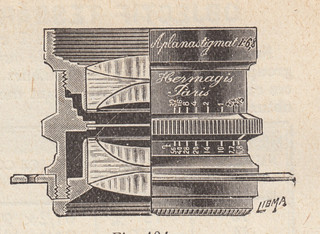
|
| Lens Diagram of the Hermagis Aplanastigmat f/6.8 (from the Photo-Sport Catalogue 1930) image by Dirk HR Spennemann (Image rights) |
The Hermagis Aplanastigmat f/6.8 was an anastigmatic 6-element version of the Aplanat with symmetrical cemented triplets.[1] It was produced from 1895[2][3] to the late 1930s. The lens design allowed for a maximum aperture of f/6.8, which among the earlier lenses was rounded up and expressed as f/7. The lens was marketed both as prime lenses and in the form of casket (trousse) sets.
Lens Variants
On record are the following lenses:[4]
Aplanastigmat with type numbers
- Aplanastigmat Nº 5 — 360 mm f/7[5]
- Aplanastigmat Nº 5bis — 310 mm f/7[5]
- Aplanastigmat Nº 6 — 270 mm f/7[5][6]
- Aplanastigmat Nº 6 bis— 230 mm f/7[5][7]
- Aplanastigmat Nº 7 — 210 mm
- Aplanastigmat Nº 7bis — 170 mm
- f/6.4 on L Joux Jumelle[9]
- Aplanastigmat Nº 8 — 140 mm
- f/7[5]
- f/6.8
- lens in barrel[10]
- in Vélocigraphe (9x12 or 13x18)[11]
- Aplanastigmat Nº 9 — 110 mm f/7[5]
Aplanastigmat with focal length
Unspecified (catalogue entries) 105 or 136mm
Aplanastigmat extra-rapide f/6.8
- Micromégas Modèle D (6.5x9, 9x12, 10x15, 13x18)[22]
- Micromégas Modèle E Métallique (6.5x9, 9x12, 10x15, 13x18)[23]
- Micromégas Modèle F Universel (9x12 horizontal)[24]
- Vélocigraphe (9x12 or 13x18)
Aplanastigmat with variable focal length
The Aplanastigmat formed the core part of the Trousse Apalanastigmatique, a barrel lens with exchangeable front and rear elements that allowed the user to make up a range of combinations. Known sets are:
- Trousse Aplanastigmatique nº 5bis = 310mm for 24 x 30
- Trousse Aplanastigmatique nº 6 =270mm for 18 x 24
- Trousse Aplanastigmatique nº 6bis = 230mm for 15 x 21
- Trousse Aplanastigmatique nº 7 = 210mm for 13 x 18
- For more detail → Hermagis Trousse Sets.
Advertisements
- ¶¶¶¶
Historic Catalogue Illustrations
|
|
| ||||||
|
Hermagis Aplanastigmat as depicted in pre World War II publications | ||||||||
Links
- ¶¶¶¶
Publications
- Gouault, M.A. (1896) Note sur deux Objectifs extra-rapides. L'Aplanastigmat Fleury-Hermagis. Bulletin de la Société industrielle de Rouen vol. 24, nº 2, pp 181–186.
Notes and References
- ↑ The name 'Aplanastigmat' was copied by a range of other lens makers or distributors.
- ↑ 2.0 2.1 2.2 'Revue de Materiel. 6b Aplanastigmat. L'amateur d' excursions photographiques. edited by J. Fleury-Hermagis. Paris: Hermagis 18 Rue de Rambuteau. nº1, October 1895, p. 5-8.
- ↑ It was still announced as 'new' in advertisements of 1898, and described as a universal anastigmat. Hermagis advertisement for the Aplanastigmat and other products, headlined Nouveautés 1898, in Le Roux, Marc (ed.), 1898, Annuaire Général et International de la Photographie 1898, p317 (p317 of 1152 as displayed; actually an un-numbered page following p160 of the original document); available to browse at E-Corpus.
- ↑ The listing is bound to be incomplete.
- ↑ 5.0 5.1 5.2 5.3 5.4 5.5 5.6 'Nouveau Aplanastigmats Extra Rapides. L'amateur d' excursions photographiques. edited by J. Fleury-Hermagis. Paris: Hermagis 18 Rue de Rambuteau. nº1, October 1895, p. 112.
- ↑ Example see Discussion thread in Galerie Photo
- ↑ Price in 1896: French Francs 281 (Gouault 1896, p. 185 ).—Example seeDiscussion thread in Galerie Photo
- ↑ worthpoint
- ↑ s/n 50031 (seen in an online auction Feb 2014).
- ↑ Photo-Sport (Paris) Catalogue 1930, p41. s/n 36909 (seen in an online auction Aug 2013).
- ↑ Velocigraphe 9x12cm, s/n 1137, with Hermagis Aplanastigmat No.8 140mm s/n 34383, seen in on-line auction (Dec 2013).
- ↑ Left lens, s/n 51356, camera body s/n 942 (seen in an online auction; Jan 2014).
- ↑ one the pair s/n 75314, camera body 6859(Early Photography).
- ↑ s/n 105683 in Compur and casket with Aplanastigmat nº 8bis and nº 10 as well as a barrel fitting (seen in an online auction; Jan 2014)
- ↑ s/n 58741 worthpoint
- ↑ s/n 144456 (seen in an online auction; Dec 2013); s/n 171188 (seen in an on-line sales site, Dec 2013)
- ↑ Price Francs 515, Héard & Mallinjod Tarif (catalogue nº 1) no date, p.5
- ↑ Price Francs 510, Héard & Mallinjod Tarif (catalogue nº 1) no date, p.6
- ↑ Price Francs 567, Héard & Mallinjod Tarif (catalogue nº 1) no date, p.6
- ↑ Price Francs 536, Héard & Mallinjod Tarif (catalogue nº 1) no date, p.7
- ↑ Price Francs 600, Héard & Mallinjod Tarif (catalogue nº 1) no date, p.7
- ↑ Micromégas Modele D on www.collection-appareils.fr by Sylvain Halgand
- ↑ [http://www.collection-appareils.fr/x/html/appareil-3155-Hermagis_Micromegas%20Modèle%20E.html
- Micromégas Modele E] on www.collection-appareils.fr by Sylvain Halgand
- ↑ Micromégas Modele F on www.collection-appareils.fr by Sylvain Halgand
- ↑ From the Photo-Sport Catalogue 1930, p41 .
| PLEASE DO NOT LINK THIS PAGE UNTIL FINISHED--MY SANDBOX IS OVERFLOWING |
CASKET entry for terminology category
In the 1890s European lens makers began to offer sets of lenses which were comprised of a lens barrel with diaphragm and a series of exchangeable front and back lens groups. These were offered in small velvet or cloth-lined 'caskets' (French: 'trousse').
By mixing and matching these front and back lens groups based on factory-provided tables, or by own experimentation, the user could create a number of present lens variations, ranging from an moderate wide-angle to a moderate tele lens. The exchange of the lens groups was facilitated by the fact that they were held in place by a bayonet or screw mechanism. Even though requiring the ongoing dis- and re-assembly of the lens, the function of these multi-focus trousse lens sets is not unlike that of modern zoom lenses: a range of focal lengths with concomitant penalties in terms of available apertures (compared to dedicated fix focus lenses).
Casket Sets have been reported, among others, from the following companies:
- Berthiot Trousse Eurygraphe N°2 serie IV
- Busch Vademecum
- Darlot
- Derogi (Paris)
- E. Français (Paris) Rectilinèaire à Foyer Multiples and Trousse Optique
- Goerz Doppel Anastigmat III
- A Gorde (Paris)
- Hermagis Trousse Aplanatique and Trousse Aplanastigmatique
- Suter (Basel)
- Taylor Taylor & Hobson No. 3 Casket
- Carl Zeiss 'D' Protarlinse Sat
| FEEL FREE TO LOOK, BUT PLEASE DO __NOT__ TOUCH... suggestions and additions are very welcome, but please leave them as a comment on the discussion page… thank you! |
E. Français
Emile Français was an optician and lens maker Paris
Publications
Français, E (1883a) Bulletin de la Société française des photographie séance du 1er juin 1883, pp. 149-150.
Français, E (1883b) Bulletin de la Société française des photographie séance du 7 décembre 1883, pp. 318.
Notes and References
| FEEL FREE TO LOOK, BUT PLEASE DO __NOT__ TOUCH... suggestions and additions are very welcome, but please leave them as a comment on the discussion page… thank you! |
E. Français Trousse Sets
Like other lens manufacturers, in 1883 E. Français began to offer trousse ( 'casket') sets of lenses which were comprised of a lens barrel with exchangeable front and back lens groups.[1] By mixing and matching based on factory-provided tables, or by own experimentation, the user could create a number of present lens variations, ranging from an moderate wide-angle to a moderate tele lens. The exchange of the lens groups was facilitated by the fact that they were held in place by a bayonet,
- Rectilinèaire à Foyer multiples nº 1 MINE
- with Waterhouse stops
- Rectilinèaire à Foyer multiples nº 2
- with Waterhouse stops[2]
- Trousse Optique N°1
- with diaphragm[3]
- Trousse Optique N°2[4]
- Trousse Optique N°3[5]
Publications
Français, E (1883a) Bulletin de la Société française des photographie séance du 1er juin 1883, pp. 149-150.
Français, E (1883b) Bulletin de la Société française des photographie séance du 7 décembre 1883, pp. 318.
Notes and References
- ↑ Français, E (1883a) Bulletin de la Société française des photographie séance du 1er juin 1883, pp. 149-150.—Français, E (1883b) Bulletin de la Société française des photographie séance du 7 décembre 1883, pp. 318.
- ↑ HermagisStudio + Trousse E.Français by Pedro Barros
- ↑ s/n 19152 Emil Francais Camera Lenses set - Trousse N°1
- ↑ E. Français Trousse Optique N°2 via www.antiq-photo.com
- ↑ s/n 20113 E. Francais Trousse No.3 Casket Lens Set Lot 715 Westlicht auction no (via www.liveauctioneers.com); E. Francais Trousse No.3 Casket Lens Set Leicashop
| FEEL FREE TO LOOK, BUT PLEASE DO __NOT__ TOUCH... suggestions and additions are very welcome, but please leave them as a comment on the discussion page… thank you! |
Hermagis Trousse Sets
Like other lens manufacturers, Hermagis began in 18¶¶ to offer trousse ( 'casket') sets of lenses which were comprised of a lens barrel with exchangeable front and back lens groups. By mixing and matching based on factory-provided tables, or by own experimentation, the user could create a number of present lens variations, ranging from an moderate wide-angle to a moderate tele lens. The exchange of the lens groups was facilitated by the fact that they were held in place by a bayonet or screw mechanism. Even though requiring the ongoing dis- and re-assembly of the lens, the function of these multi-focus trousse lens sets is not unlike that of modern zoom lenses: a range of focal lengths with concomitant penalties in terms of available apertures (compared to dedicated fix focus lenses).
Over time, the design of the trousse sets changed. The early designs saw a small bayonet mount relying on two lugs that would slot into place. Among these, examples with cursive engraving of the focal length preceded those where angular letters were used. The later design utilised a ¼ screw mechanism.
|
|
| ||||||
|
|
| ||||||
|
Designs for mounting the exchangeable front and rear elements of Hermagis trousse sets | ||||||||
Overview of Trousse Sets
The following trousse sets can be documented:
For the various Trousse Sets Hermagis furnished tables which set out the possible combinations of the various lenses and which focal lengths and coverage can be achieved by them.
Trousse Aplanatique
The base lens design is that of the Hermagis Aplanat. Four base focal length combinations were marketed from 270 to 400mm:
Trousse Aplanétique nº 4 (for 24 x 30)
- Sold as as trousse set comprising the lens barrel with diaphragm and ¶¶¶
Trousse Aplanétique nº 5 (for 18 x 24)
- Sold as as trousse set comprising the lens barrel with diaphragm and ¶¶¶
Trousse Aplanétique nº 5bis (for 24 x 30)
- Sold as as trousse set comprising the lens barrel with diaphragm and ¶¶¶
Trousse Aplanétique nº 6 (for 13x18)
- Sold as as trousse set comprising the lens barrel with diaphragm and ¶¶¶
2 x Apl. No.6, Apl. No.7, G.A. No.7 set of waterhouse stops s/n 29864 eBay Jan2014
Trousse Aplanastigmatique
The base lens design is that of the Hermagis Aplanastigmat. Four base focal length combinations were marketed from 210 to 310mm:
Trousse Aplanastigmatique nº 5bis (310mm for 24 x 30)
- Sold as as trousse set comprising the lens barrel with diaphragm and ¶¶¶
Trousse Aplanastigmatique nº 6 (270mm for 18 x 24)
- Sold as as trousse set comprising the lens barrel with diaphragm and ¶¶¶
Trousse Aplanastigmatique nº 6bis (230mm for 15 x 21)
- Sold as as trousse set comprising the lens barrel with diaphragm and ¶¶¶
Trousse Aplanastigmatique nº 7 (210mm for 13 x 18)
- Sold as as trousse set comprising the lens barrel with diaphragm and two nº 7 exchangeable lens groups as well as well as a nº 8 and a nº 9 lens group. Given the popular size of 13x18 this is the most common of the trousse sets.[1] For the variation of focal lengths and view angles, as well as the resulting the plate coverage that can be derived from this set, see below.
Coverage of the lens combinations of the various Trousse Sets
Hermagis company publications furnish tables for Trousse Sets that set out the possible combinations of the various lenses and which focal lengths and coverage can be achieved by them. As they are scattered, they have been reproduced here for reference purposes.
Trousse Aplanastigmatique nº 5bis (310mm for 24 x 30)
Trousse Aplanastigmatique nº 6 (270mm for 18 x 24)
Trousse Aplanastigmatique nº 6bis (230mm for 15 x 21)
Trousse Aplanastigmatique nº 7 (210mm for 13 x 18)
Sold as as trousse set comprising the lens barrel wih diaphragm and two nº 7 exchangeable lens groups as well as well as a nº 8 and a nº 9 lens group. ¶¶¶ 1896 page ¶¶
| Short Exposures | Long Exposures | ||||||||||||||
| Nº | Nature | Focal Length |
Front Cell |
Back Cell |
Diaphragm Setting |
Aperture f/ |
Format | View Angle |
Diaphragm Setting |
Aperture f/ |
Format | View Angle |
|||
| I | Aplanastigmat Extra Rapide | 21 | 7 | 7 | 1/3 | 7.7 | 13x18 | 46° | 1 | 10 | 15x21 | 53° | |||
| II | Aplanastigmat Rapide | 16.3 | 7 | 8 | 2 | 10.6 | 12 x16 | 53° | 4 | 15.2 | 13x19 | 58 | |||
| III | Aplanastigmat Grand Angulaire | 14.3 | 7 | 9 | 4 | 13.3 | 10x15 | 56° | 8 | 18.6 | 12x16 | 60° | |||
| IV | Grand Angulaire | 12 | 8 | 9 | 4 | 11 | 9x12 | 53° | 16 | 22 | 13x18 | 74° | |||
| V | Simple Rapide | 39 | — | 7 | 1/3 | 13.5 | 13x18 | 26° | 1 | 18.7 | 15x21 | 30° | |||
| VI | Simple Rapide | 26 | — | 8 | 2 | 17 | 12x16 | 34° | 4 | 25 | 13x18 | 38° | |||
| VII | Simple Rapide | 20 | — | 9 | 2 | 13.3 | 9x12 | 33° | 4 | 18.6 | 12x16 | 44 | |||
Notes and References
- ↑ Documented examples of the Trousse Aplanastigmatique nº 7: s/n 32442 lotissimo; s/n 34972 this thread on collection-appareils; s/n 40536 this thread on collection-appareils; s/n 95431 (Photographica Collection Dirk HR Spennemann) ¶¶¶; s/n 208388 Lotissimo.
| FEEL FREE TO LOOK, BUT PLEASE DO __NOT__ TOUCH... suggestions and additions are very welcome, but please leave them as a comment on the discussion page… thank you! |
Hermagis Major
The Hermagis Major f/4.5 was an Anastigmat available in various focal lengths. With a maximum aperture of f/4.5, Hermagis marketed the lens for folding cameras destined for the advanced amateur market, with the slower Magir (f/6.3) for the beginning amateur.[1] While it was sold under the Hermagis (Paris) name from 19¶¶ to the late 1930s, the lens most probably manufactured by SOM.[2]
The Major lens has been encountered as:
- 75mm f/4.5
- on Cady Bubi[3]
- 105mm f/4.5
- Anastigmat Major
- 50mm f/4.5[9]
Notes and References
- ↑ Optique and Mécanique de Précision. Appareils pour la Photographie. Etablissements Hermagis, 1933, p. 11.
- ↑ ADD PRINCELLE REF
- ↑ (seen in an online offering; Jan 2014);
- ↑ s/n243753 (seen in an online offering; Jan 2014); s/n 244165 (seen in an online auction; Dec 2013), s/n 259844 in Vario (seen on YouTube; Dec 2013)
- ↑ (seen in an online offering; Jan 2014);
- ↑ s/n 254284, folder body possibly of German manufacture (seen in an online auction; Dec 2013)
- ↑ Price Francs 480, Héard & Mallinjod Tarif (catalogue nº 1) no date, p.6
- ↑ Price Francs 506, Héard & Mallinjod Tarif (catalogue nº 1) no date, p. 7
- ↑ s/n 329240 (seen in an online auction; Nov 2013)
| FEEL FREE TO LOOK, BUT PLEASE DO __NOT__ TOUCH... suggestions and additions are very welcome, but please leave them as a comment on the discussion page… thank you! |
Hermagis Magir
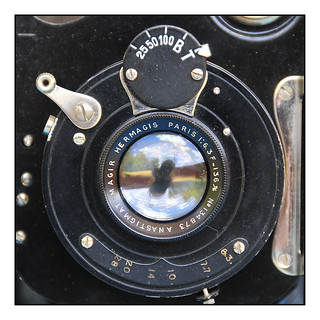
|
| Hermagis Magir 136mm f/6.3 in plain Gitzo shutter Héard & Mallinjod 'Hemax' 6 x9 plate camera image by Dirk HR Spennemann (Image rights) |
The Hermagis Magir f/6.3 was an Anastigmat available in various focal lengths. With a maximum aperture of f/6.3, Hermagis marketed the lens for cameras destined for the beginning amateur market, with the slightly faster Major (f/4.5) aimed at the more advanced amateur.[1] While it was sold under the Hermagis (Paris) name from 19¶¶ to the late 1930s, the actual lens was most probably already manufactured by SOM.[2]
The Magir lens has been encountered as:
- unspecified (either 105 or 136mm)
- 105mm f/6.3
- Héard & Mallinjod Hemax 120 roll film camera in Gitzo shutter[10]
- Héard & Mallinjod Siva (c. 1930)[11]
- 125mm f/6.3
- in shutters
- Photo-Hall Perfect Rollfilm nº 6 in Vario shutter[14]
- as barrel lens[15]
- in shutters
- 136mm f/6.3
- in shutters
- DeMaria-Lapierre ¶¶¶ 6 x 9 plate camera with Gitzo B3 shutter[16]
- Héard & Mallinjod Hemax 6 x 9 plate camera with Gitzo B3 shutter[17]
- Héard & Mallinjod Hemax 6 x 9 plate camera with Gitzo shutter[18]
- unamed 9x12 plate camera in Ibsor shutter in[19]
- as barrel lens[20]
- in shutters
Notes and References
- ↑ Optique and Mécanique de Précision. Appareils pour la Photographie. Etablissements Hermagis, 1933, p. 11
- ↑ ADD PRINCELLE REF
- ↑ Price Francs 258, Héard & Mallinjod Tarif (catalogue nº 1) no date, p.4
- ↑ Price Francs 270, Héard & Mallinjod Tarif (catalogue nº 1) no date, p.4
- ↑ Price Francs 375, Héard & Mallinjod Tarif (catalogue nº 1) no date, p.5
- ↑ Price Francs 379, Héard & Mallinjod Tarif (catalogue nº 1) no date, p.6
- ↑ Price Francs 379, Héard & Mallinjod Tarif (catalogue nº 1) no date, p.6
- ↑ Price Francs 405, Héard & Mallinjod Tarif (catalogue nº 1) no date, p. 7
- ↑ Price Francs 482, Héard & Mallinjod Tarif (catalogue nº 1) no date, p.7
- ↑ s/n 172890 (Image by Dirk HR Spennemann); s/n 185138 (seen in an on-line auction, October 2013)
- ↑ Sylvain Halgand 'Siva' [3]
- ↑ s/n 280712 (G. Even's site)
- ↑ s/n 187850 (Image by Dirk HR Spennemann)
- ↑ s/n 236967 (seen in an on-line auction, Feb 2014)
- ↑ s/n193966 (seen in an online auction; Dec 2013)
- ↑ s/n 214347 (forum entry on Sylvain halgand's site)
- ↑ s/n 233573 (Image by Dirk HR Spennemann) ¶¶¶
- ↑ s/n 134873 (Image by Dirk HR Spennemann)
- ↑ s/n 210464 (seen in an online auction; Dec 2013)
- ↑ s/n 239670 (seen in an on-line auction, October 2013)
- ↑ s/n 141420 (seen in an on-line auction, October 2013)
| FEEL FREE TO LOOK, BUT PLEASE DO __NOT__ TOUCH... suggestions and additions are very welcome, but please leave them as a comment on the discussion page… thank you! |
Hermagis Inscription Types
| Type | Date Range | Image | Transcription | ||
| ~1900 |
|
Nº 22,527 HERMAGIS Optn Fabt Bté s.g.d.g. Paris (~1900)[1] | |||
| ~1905 |
|
HERMAGIS Optn Fabt Bté s.g.d.g. Paris Nº 30,953 (~1905)[2] | |||
| 1924 |
|
EXTRA RAPIDE Nº 5 HERMAGIS Nº 89664 (1924)[3] | |||
| images by Dirk HR Spennemann (Image rights) | |||||
Notes
- ↑ Hermagis Aplanat Nº 8, s/n 22527 (Photographica Collection Dirk HR Spennemann)
- ↑ Hermagis Aplanat Nº 8, s/n 30953 (Photographica Collection Dirk HR Spennemann)
- ↑ Hermagis Extra Rapide nº 5 s/n 89664 Photographica Collection Dirk HR Spennemann
Hermagis Serial Numbers
Hermagis lenses carry sequential serial numbers irrespective of focal length or design. The sides of the lens cells are inscribed with 'Hermagis á Paris' or merely 'Hermagis Paris' as well as the focal length and year of production (first etched, later in pencil). Based on a series of observations, the following serial number and date pairs have been compiled:
Table 1 Documented serial number and date combinations for Hermagis lenses[1]
| Serial number | Year | Lens Type | Reference |
| 8077 | no year written | [1] | |
| 10529 | 1868 (17 May) | Portrait #9 | [2] |
| 13240 | 1867 | [1] | |
| 13657 | 1868 | [1] | |
| 13995 | 1867 | [1] | |
| 14098 | 1868 | [1] | |
| 14361 | 1873 | Extra Rapide nº 5 | [3] |
| 14399 | 1868 | [4] | |
| 14659 | 1868 | [1] | |
| 15067 | 1872 | [1] | |
| 15505 | 1872 | [1] | |
| 15512 | 1873 | [1] | |
| 15744 | 1873 | [1] | |
| 15971 | 1874 | [1] | |
| 16723 | 1876 | [1] | |
| 16784 | 1876 | [1] | |
| 16944 | 1876 | [1] | |
| 18702 | 1883 | [1] | |
| 44064 | 1907 | [1] | |
| 44108 | 1907 | Objectif Cinema 150mm | [5] |
| 46028 | 1908 | [1] | |
| 58002 | 1920 | Eidoscope #3 f/5 | [1] |
| 62259 | 1919 | Objectif Cinema 110mm | [6] |
| 68363 | 1920 | Eidoscope #3 f/5 | [1] |
| 89664 | 1924 | Extra Rapide Nº 5 | [7] |
| 95567 | 1924 | Eidoscope #1 f/5 | [1] |
| 132115 | 1928 | Objectif Cinema 150mm | [8] |
| 146607 | 1929 | Eidoscope #4 f/5 | [1] |
| 150059 | 1929 | Cinema | [9] |
| 277252 | [blank] | Objectif Cinema 110mm | [10] |
Notes
- ↑ 1.00 1.01 1.02 1.03 1.04 1.05 1.06 1.07 1.08 1.09 1.10 1.11 1.12 1.13 1.14 1.15 1.16 1.17 1.18 1.19 1.20 1.21 Unless otherwise specified, the reference for the serial number/date can be found in this discussion thread at www.largeformatphotography.info.
- ↑ in pencil on rear element "Hermagis á Paris 17 - 5 - 1868" Portrait size #9 (based on lens Ø) (Photographica Collection Dirk HR Spennemann).
- ↑ Flickr user luphot.—It is possible that the lens has lost its historic integrity and that the front cell (carrying the early serial number) was replaced in the past.
- ↑ eBay
- ↑ This discussion thread at www.largeformatphotography.info
- ↑ rear group: "110+19" .—Cinema 110mm ø 43mm (Photographica Collection Dirk HR Spennemann)
- ↑ "Hermagis á Paris (ER 24)" Hermagis Extra Rapide nº 5 Photographica Collection Dirk HR Spennemann
- ↑ "Hermagis Paris B 24" Objectif Cinema 150mm ø58mm Photographica Collection Dirk HR Spennemann
- ↑ (listed on http://www.ksmt.com)
- ↑ Cinema 110mm ø 58mm (Photographica Collection Dirk HR Spennemann)
| FEEL FREE TO LOOK, BUT PLEASE DO __NOT__ TOUCH... suggestions and additions are very welcome, but please leave them as a comment on the discussion page… thank you! |
